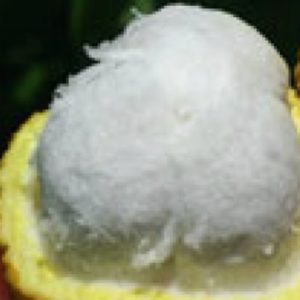Garcinia (Rheedia) madruno (acuminata)
Madruno, bacuri, lemon drop mangosteen
Origin
The madruno originates from Eastern Amazonian non-flooded tropical lowland regions and is now grown in Costa Rica, Panama, the Guianas and Venezuela at elevations up to 1200m in the Andes. It is not widely known outside Central and South America but has been introduced into Florida.
Climate
Pantropical with rainfall of 1000-3000mm pa, including those with a prolonged dry season.
Plant Description
An evergreen understory tree with apical dominance and a dense crown up to 25m high in its native habitat but far less (6-10m) elsewhere or in cultivation. The simple entire opposite elliptical to oblong coriaceous shiny glabrous leaves, 6-16 X 4-6cm are dark green on the upper surface and lighter on the underside. There is a distinct marginal leaf vein and juvenile leaves are pale bronze.
Relatives
It is a member of the Clusiaceae family (formerly Guttiferae) which contains about 35 genera and 1200 species. Other relatives include mangosteen, the best known fruit in the family, and imbe, bacuripari, kokum, African apricot and mamey. There have been few recent taxonomic reviews of the family, resulting in considerable uncertainty in the correct relationships between species, and there is consequently a pressing need for modern studies, especially using molecular techniques. There are many confusing common names of G. madruno.
Soils
Tolerant to most soil types, with a preference for well-drained sandy soils.
Propagation
Usually by seeds which are recalcitrant. In good media, germination and early growth is rapid.
Cultivars
Apart from selection of random superior trees, very little development work has been done on the species. Plants are not usually grafted on their own rootstocks and there have been reports of incompatibility between varieties.
Flowering and Pollination
The species is andromonoecious with inflorescences borne as fascicles on young branches in the axils of recently abscised leaves. The fragrant flowers have creamy-white petals, numerous light yellow free stamens and a central ovary with 4-5 locules. Bisexual flowers have fewer stamens (ie <25-30) than the staminate flowers which lack an ovary. Reproductive biology has not been reliably studied, but they seem to benefit from cross-pollination.
Cultivation
As a forest tree it can tolerate partial shade. Little information is available on fertilisation requirements, but manures and refuse are used in home gardens in the Americas.
Wind Tolerance
No problems reported but in its normal habitat in forests it is sheltered.
Pruning
Little is done, apart from normal removal of any dead branches and height control.
The Fruit
Fruits take 3-6 months to mature and are ovoid to sub-globose, sometimes with a nipple at one or both ends, 3.5-5cm long. There is a thick verrucose orange-yellow rind that is not eaten. They exude a yellow latex when bruised or cut. The limited white mucilaginous pulp surrounds 1-3 oblong brown seeds and has an intriguingly sweet tangy flavour. Sometimes one or more seeds fail to develop and these parthenocarpically formed segments have a greater amount of edible pulp. It has no particular nutritional strengths but does contain some flavonoid antioxidants. Almost all the sugar content is fructose.
Fruit Production and Harvesting
Trees in the Americas are mainly grown in home gardens and small mixed orchards, with some fruit collected from wild trees. Seedlings can start to fruit when the plant is only 3m high. In ideal environments fruit may be produced throughout the year but elsewhere they mature in spring and summer. Fruit fall from the tree when ripe, protected from bruising by the thick rind. If kept shaded and ventilated, fruit maintain pulp quality for up to a week at ambient temperature. A good 10-year-old plant can produce hundreds of fruit.
Fruit Uses
Fruit are almost always eaten fresh as the limited pulp adheres quite strongly to the seeds, pre-disposing against processing into juices etc.
Pests and Diseases
Since they are not grown in large mono-cultures where pest and disease problems are accentuated, there are usually minimal problems.
Comments
This is a rare one for WA and probably one of the few tropical Garcinias that can be successfully grown, with care, in south west regions. Place in as warm a microenvironment as possible and ensure plants receive sufficient water. The unusual taste of the fruit will add variety to others in your harvest, and its shiny dark green and dense foliage makes it ornamentally attractive.

